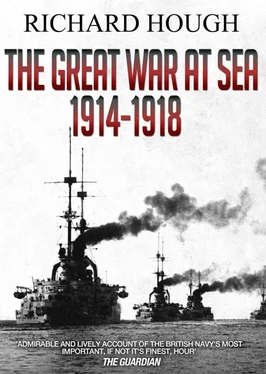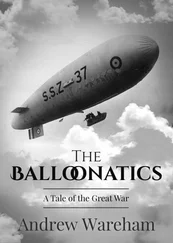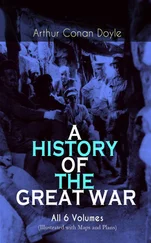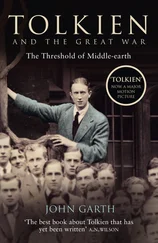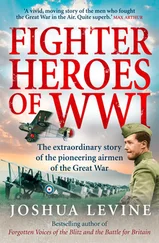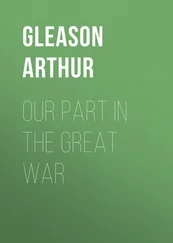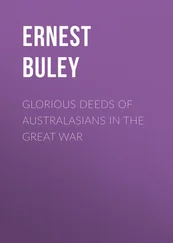Then the searchlight was back and this time it stayed on them for 30 seconds. Lawrence gave a strained laugh. They had been seen. Boyle sent Lawrence below and ordered diving stations. By the time the hatch had been shut behind them, and they had swept down the iron ladder into the control room, two shots been fired. Lawrence settled down with his notebook in the control room. “Now we had really started on our long dive,” he wrote later.
Everything now depended on the captain’s skill and the resources of their electric batteries to drive them underwater.
“ Underhand , unfair and damned un - English .”
The definition of submarines articulated by Admiral Sir Arthur Wilson in 1901.
We forget these days, when technology moves so slowly – I have been travelling on jumbo jets now for almost four decades – just how fast technological change was racing ahead a century ago. So fast, in fact, that the pioneers of motor transport, aviation and cinematography in the 1890s and 1900s often lived to see their full fruition in the 1960s. It was the same with submarines.
When the French navy ordered their first submarines at the turn of the twentieth century, it was almost inevitable that their sceptical British opposite numbers would do so too – even though official naval policy was to shun submarines. The First Sea Lord joked that they would hang submariners as pirates if they were captured. In April 1901, the House of Commons was told that the Royal Navy was ordering five submarines, designed by the Irish American submarine pioneer John Philip Holland, in order to “assess them”.
So it was that the first five submarines, the Holland class, joined the Royal Navy. There was the usual confusion with new technology about what kind of skills would be needed to make it work. It occurred to Reginald Bacon, described once as “the cleverest man in the navy”, that what they really needed was a series of enthusiastic torpedo experts from the so-called electrical branch. He therefore applied for the position of Inspecting Captain of Submarines, and got the job:
“I knew nothing about submarines; nor did anyone else, so the first thing to do was to sit down and think out where the difficulties were that we were likely to come across and arrived at methods by which they might be forestalled. The result was rather peculiar; for all the problems that I originally considered to be likely to be difficult turned out to be simple, and several of those that appeared to be simple gave, in the end, an infinity of trouble.”
The new submarines were 63 foot long, as long as a cricket pitch, and full of levers. There were complex experiments about crews breathing the same air for long periods of time. In case of poisonous fumes, which remained a serious danger from the accidental combination of batteries and seawater, a small cage of white mice was provided and the crew of eight kept a close eye on their behaviour whenever they dived.
The new submarine service attracted officers and ratings who had just got married, or planned to be, and needed the extra pay – submarine pay was almost twice that of those in the conventional navy – and because there was less discipline. The service was always more idiosyncratic than the regular naval life, and attracted those who were most thrilled by technology: many of the first submarine commanders – Courtney Boyle included – owned motorcycles and enjoyed riding them fast. Submarine officers dressed in a bizarre mixture of wing collars, monkey jackets and sea boots (one submarine captain greeted a visiting admiral in carpet slippers in 1914). They attracted the mavericks who enjoyed the disapproval of the naval old guard, led by the abrasive Admiral Sir Arthur Wilson, known to the ranks as Old ‘ard ‘eart. The very classlessness of the submarines, with only maybe a curtain between the officers and other ranks, made the old salts nervous.
By 1904, Bacon had created the bones of the new service, with an ancient cruiser called Thames moored out of the way – where their presence would not offend the old guard – at the end of Fareham Creek, near Portsmouth. It was surrounded by the new classes of tiny British-built submarines, the A class and B class. It was there that many of the famous British submarine pioneers were sent for their training, including Max Horton, Martin Nasmith, Godfrey Herbert, Archibald Cochrane, Ferdinand Feilmann, Charles Little, and Charles Brodie (known by his initials C. G.). It was Horton who would later start the submarine tradition of flying a skull and crossbones, as an ironic dig at their critics in the respectable navy.
Brodie and Horton fell heavily against the fore torpedo tubes on their first dive in a Holland submarine, unaware that they had to hold on. By then, the submarine service had suffered the first of many tragic disappearances. The first British-built submarine, A1, was lost with all hands by Nab Tower in the Solent during a dive in 1904, hit by a mail steamer while submerged. The submarines were all recalled to have a watertight hatch fitted between the control room and the conning tower.
* * *
The year 1904 was when Fort Blockhouse was taken over from the army on a fifty-year lease and the submariners moved to Gosport. It was also the year when Courtney Boyle joined the submarine service, known by then as ‘The Trade’ because of one insult thrown in their direction that they looked like ‘unwashed chauffeurs’. He was 21, tall and thin, and extremely reserved, unlike so many of the other submarine officers. Courtney Boyle had been born in Carlisle, and christened Edward after his father – he always used his second name – but he and his younger brother Gerald, and his three sisters Kathleen, Gladys and Dulcie, were brought up in Hove (15 Norton Road).
There was heroism in the family: Courtney’s father was Colonel Edward Boyle, who had taken part in the 1868 Abyssinian Campaign. His uncle Richard, also his godfather, was the engineer who led the desperate and successful defence of Arrah House during the Indian Mutiny. But Courtney himself was not obviously in the hero mould, shy and perhaps not quite as confident as his fellows. He was at Cheltenham College and had been known as a successful wing playing rugby at HMS Britannia , the naval training establishment on the River Dart. He joined the battleship HMS Caesar as a midshipman in 1899 on China Station.
‘The Trade’, when he joined it, was a close-knit community of pioneers, united by the disdain heaped upon them by the rest of the navy and by the sheer peril of the early submarines, before any means of underwater escape had been devised. By the end of the year spent training, Boyle was appointed to his first command, taking over as the second or third commander of the tiny and awkward Holland No. 1, only three years old but already out of date.
This was an experimental period for everyone. Not only was it uncertain how submarines would manoeuvre underwater – the Hollands all did so by sloping forwards alarmingly – but the fixed periscope turned the image upside down and was anyway almost impossible to make out anything through. In 1905, Feilmann demonstrated this in A4, practicing an attack on a submarine tender in the Solent. He mistook a ladies’ red parasol on the beach at Alverstoke for the red flag of the target. His torpedo shot up the beach right next to the lady, who was the wife of a retired colonel, and legal action was narrowly averted.
Despite all the problems, the great success of the fleet manoeuvres of 1910 convinced the most senior doubter, and Admiral Wilson was then First Sea Lord. He ordered the first ocean-going submarines, the D class. He also appointed a man he believed had the drive and enthusiasm to turn them into an elite force, one of the heroes of the Boxer Rebellion a decade before, Roger Keyes.
Читать дальше
